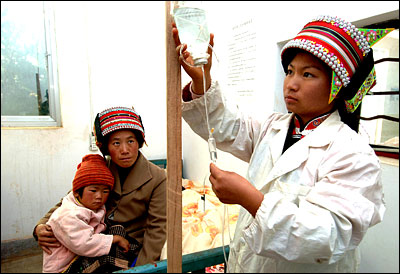 |
China has 1.51 doctors and 2.45 hospital beds for every 1,000 people. In Beijing, Shanghai, Tianjin, Chongqing and other large cities, general traditional Chinese medicine and hospitals specializing in, for example, cancer, cardio-and cerebro-vascular disorder, ophthalmology, dentistry and infectious diseases can be found. Medium-sized cities throughout China have general and specialized hospitals with modern facilities. Medical treatment, disease prevention, and health-care networks have taken shape at county, township and village levels. With the establishment and development of health and medical-care organizations and the gradual spread of good hygiene habits, infectious and parasitic diseases, formerly the major killers, have been replaced by cancer, cardio- and cerebro-vascular diseases and creating a mortality pattern close to that of the developed countries. The health of urban and rural residents has been greatly improved; the average life expectancy is now 71.95 years, five more than the world average.
"Prevention first" is one of the important principles in all China's health care work. All administrations have created hygiene and disease-prevention organizations responsible for overall management of these functions including hygiene and epidemic-prevention stations, forming a nationwide network of hygiene supervision and control. In order to eliminate or control some serious epidemic and local diseases endangering people's heath, the National People's Congress and State Council issued the Law on the Prevention and Cure of Infectious Diseases, the National Plan for Poliomyelitis Elimination by the Year 1995, and National Outline for IDD Elimination by the Year 2000 and other documents. Disease prevention work has been further strengthened and made outstanding achievements.
In May 2003, the State Council issued Regulations on Public Health Emergencies, establishing a legal framework for tackling public health crises. Furthering its cooperation with the World Health Organization, the state is planning significant investment in a system to handle all public health crises, improving the responsiveness and capabilities of emergency centers, treatment and hospital information systems.
Reform in medical care and changes in the make-up of society have prompted the spread to most cities of community-based health services whose major role is anti-epidemic work but which also provide treatment and healthcare. These popular organizations are geared to handle at grassroots level problems arising from increased urbanization, an aging population, changes in disease patterns and social strata.
In 2003, China embarked on a new rural cooperative medical care system. Based on major illness health insurance coverage, the system is based on a payment plan by the individual, financial support from the collective, and subsidies from the government. If farmer who has joined the scheme is hospitalized, incurred costs can be reimbursed according on a sliding scale. This medical care system is expected to cover the whole country in 2010. Meanwhile, China has implemented a medical-aid system for rural areas offering medical aid to poor farmers who are seriously ill. A standardized rural medical-aid system had been established throughout the country by the end of 2005. The fund, with special allocations from various levels of government with donations from people from all walks of life, will be used exclusively for medical aid.

